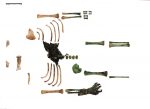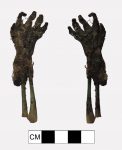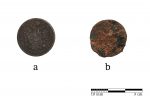 A study of the partially mummified remains of an infant found in southern Hungary has identified it as the first reported instance of mummification entirely by copper. The remains were unearthed during excavations that took place between 1982 and 1992 in a Late Medieval churchyard in the village of Nyárlőrinc. Almost all of the 541 graves excavated at the site dated between the 12th and 16th century, but a few solitary burials took place through the 19th century when the cemetery was no longer in official use but remnants of the church walls were still standing.
A study of the partially mummified remains of an infant found in southern Hungary has identified it as the first reported instance of mummification entirely by copper. The remains were unearthed during excavations that took place between 1982 and 1992 in a Late Medieval churchyard in the village of Nyárlőrinc. Almost all of the 541 graves excavated at the site dated between the 12th and 16th century, but a few solitary burials took place through the 19th century when the cemetery was no longer in official use but remnants of the church walls were still standing.
 The infant’s remains were found in a ceramic pot buried at the edge of the cemetery. In its mummified hand was a copper coin minted between 1858 and 1862, which narrows down the burial date to sometime inside that four year range, 150 years after the cemetery fell into disuse. After their excavation, the remains were put in a box separate from the pot and coin and were forgotten about until 2005 when János Balázs and Zoltán Bölkei of the University of Szeged rediscovered them and noted the unusual mummified right hand and section of dorsal skin.
The infant’s remains were found in a ceramic pot buried at the edge of the cemetery. In its mummified hand was a copper coin minted between 1858 and 1862, which narrows down the burial date to sometime inside that four year range, 150 years after the cemetery fell into disuse. After their excavation, the remains were put in a box separate from the pot and coin and were forgotten about until 2005 when János Balázs and Zoltán Bölkei of the University of Szeged rediscovered them and noted the unusual mummified right hand and section of dorsal skin.
 The bones are tiny — the baby was no more than 11 to 13 inches long and weighed one or two pounds — which made it a pre-term infant gestated no more than seven lunar months. The baby was born premature and was either stillborn or died shortly after birth. The hand is one of the smallest and youngest mummified human remains ever discovered. Because the little body was placed in a clay pot and buried in the abandoned cemetery in the second half of the 19th century, researchers hypothesize that the baby was not baptized and had to be interred in secret.
The bones are tiny — the baby was no more than 11 to 13 inches long and weighed one or two pounds — which made it a pre-term infant gestated no more than seven lunar months. The baby was born premature and was either stillborn or died shortly after birth. The hand is one of the smallest and youngest mummified human remains ever discovered. Because the little body was placed in a clay pot and buried in the abandoned cemetery in the second half of the 19th century, researchers hypothesize that the baby was not baptized and had to be interred in secret.
Mummified human remains are rare in Hungary and most of them are intentional rather than spontaneous (the Vác mummies being the most salient exception). Of the few spontaneous mummified remains found in Hungary, this is the only known example of a neonate/perinate.
The bones Dr. Balázs found were so small they could have been confused with a rat’s. Several, including some vertebrae, a hip bone and the leg bones were stained green. Both forearms were green as well, but the right one was still covered in desiccated flesh. The skin near the back was also mummified and embedded with five vertebrae pieces. Most of the ribs, a shoulder bone and two humerus bones were not discolored. […]
Archaeologically speaking, green bones are not uncommon at grave sites. Bronze or copper jewelry can often discolor skeletons as they degrade, and Dr. Balázs thought the child’s body came in contact with some sort of metal. But how did that mystery metal object end up near its tiny hands?
 That mystery was solved when the team discovered that the nearby Móra Ferenc Museum also had boxes in storage from the Nyárlőrinc dig. Inside those boxes the researchers found the ceramic pot and the corroded copper coin. Records indicated this was the pot the perinate had been buried in and that the coin had been found right next to it.
That mystery was solved when the team discovered that the nearby Móra Ferenc Museum also had boxes in storage from the Nyárlőrinc dig. Inside those boxes the researchers found the ceramic pot and the corroded copper coin. Records indicated this was the pot the perinate had been buried in and that the coin had been found right next to it.
Testing of the remains and comparisons with the remains of two other infants found in the graveyard revealed exceptionally high copper levels that could not be justified by contact with the soil or the ceramic pot. Concentrations of copper in the bones of the mummified perinate were 497 times higher than the concentrations in other mummified remains recorded in the published literature.
The team concluded that before the child was placed in the pot and buried, someone put the copper coin into its hand. Many cultures in antiquity have buried their dead with coins as a way to pay a mythical ferryman to take their souls into the afterlife.
In this case, the copper’s antimicrobial properties protected the child’s hand from decay. Along with the conditions inside the vessel, it helped mummify the baby’s grasp.